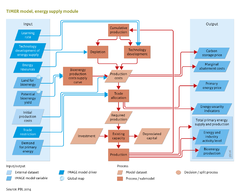Energy supply/Description: Difference between revisions
Jump to navigation
Jump to search
No edit summary |
No edit summary |
||
| Line 51: | Line 51: | ||
</td></tr> | </td></tr> | ||
</table> | </table> | ||
Fossil fuel resources are aggregated to five resource categories for each fuel (Table above). Each category has typical production costs. The resource estimates for oil and natural gas supply imply that for conventional resources supply is limited to only two to eight times the 1970–2005 production level. Production estimates for unconventional resources are much larger, albeit very speculative. Recently, some of the occurrences of these unconventional resources have become competitive such as shale gas and tar sands. For coal, even current reserves amount to almost ten times the production level of the last three decades. For all fuels, the model assumes that, if prices increase, or if there is further technology development, the energy could be produced in the higher cost resource categories. The values presented in Table above represent medium estimates in the model, which can also use higher or lower estimates in the scenarios. The final production costs in each region are determined by the combined effect of resource depletion and learning-by-doing. | |||
===Trade=== | |||
Trade is dealt with in a generic way for oil, natural gas and coal. In the fuel trade model, each region imports fuels from other regions. The amount of fuel imported from each region depends on the relative production costs and those in other regions, augmented with transport costs, using multinomial logit equations. Transport costs are calculated from representative interregional transport distances and time- and fuel-dependent estimates of the costs per GJ per kilometre. | |||
To reflect geographical, political and other constraints in the interregional fuel trade, an additional 'cost' is added to simulate trade barriers between regions (this costs factor is determined by calibration). Natural gas is transported by pipeline or liquid-natural gas ({{abbrTemplate|LNG}}) tanker, depending on distance, with pipeline more attractive for short distances. In order to account for cartel behaviour, the model compares production costs with and without unrestricted trade. Regions that can supply at lower costs than the average production costs in importing regions (a threshold of 60% is used) are assumed to supply oil at a price only slightly below the production costs of the importing regions. Although also this rule is implemented in a generic form for all energy carriers, it is only effective for oil, where the behaviour of the OPEC cartel is simulated to some extent. | |||
To reflect geographical, political and other constraints in the interregional fuel trade, an additional 'cost' is added to simulate trade barriers between regions (this costs factor is determined by calibration). Natural gas is transported by pipeline or liquid-natural gas (LNG) tanker, depending on distance, with pipeline more attractive for short distances. In order to account for cartel behaviour, the model compares production costs with and without unrestricted trade. Regions that can supply at lower costs than the average production costs in importing regions (a threshold of 60% is used) are assumed to supply oil at a price only slightly below the production costs of the importing regions. Although also this rule is implemented in a generic form for all energy carriers, it is only effective for oil, where the behaviour of the OPEC cartel is simulated to some extent. | |||
}} | }} | ||
Revision as of 16:46, 22 May 2014
Parts of Energy supply/Description
| Component is implemented in: |
|
| Related IMAGE components |
| Projects/Applications |
| Key publications |
| References |
